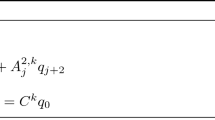Abstract
In spite of, several mathematical approaches of the Lorenz solver system have been declared, fast and effective approaches has always been the direction in which scientists are trying to achieve. Based on this challenge, this paper initiates to boost the processing of Lorenz ordinary differential equations (ODE) system by applied hardware accelerator to take advantage of parallel architecture. A chaotic solution is found for various parameters and primary conditions. Specifically, Lorenz attractor was a group of chaotic outputs of the Lorenz equation. The 3D plotted the shape of Lorenz attractor was like “‘butterfly wings” which depend on initial conditions of the nonlinear system. Lorenz has more application in the real world as in biomechanical, physical, Control systems. As noted earlier, the Lorenz system is a scheme of ordinary differential equations exhibiting chaotic behavior for certain parameter values and initial conditions. The result presents the different Lorenz waveform of various parameter values to calculate the time of execution for each case study on a different platform.
Access this chapter
Tax calculation will be finalised at checkout
Purchases are for personal use only
Similar content being viewed by others
References
Philippson, P.: The Emergent Self: An Existential-Gestalt Approach. Routledge (2018)
Strogatz, S.H.: Nonlinear Dynamics and Chaos: with Applications to Physics, Biology, Chemistry, and Engineering. CRC Press, Boca Raton (2018)
Lorenz, E.N.: Section of planetary sciences: the predictability of hydrodynamic flow. Trans. New York Acad. Sci. 25(4) Series II, 409–432 (1963)
Curry, J.H.: A generalized Lorenz system. Commun. Math. Phys. 60(3), 193–204 (1978)
McLaughlin, J.B., Martin, P.C.: Transition to turbulence in a statically stressed fluid system. Phys. Rev. A 12(1), 186 (1975)
Strogatz, S.H.: Nonlinear Dynamics and Chaos: with Applications to Physics, Biology, Chemistry, and Engineering. CRC Press, Boca Raton (2018)
Muthukumar, S., Thangapandi, C., Mahalakshmi, S., Veeramuni, M.: Analytical solution of a differential equation that predicts the weather condition by lorenz equations using homotopy perturbation method. Glob. J. Pure Appl. Math. 13(11), 8065–8074 (2017)
Bradley, L.: The Butterfly Effect Chaos and Fractals. Space Telescope Science Institute, Baltimore (2010)
Viswanath, D.: The fractal property of the Lorenz attractor. Phys. D: Nonlinear Phenomena 190(1–2), 115–128 (2004)
Algaba, A., Merino, M., Rodrguezluis, A.J.: Superluminal periodic orbits in the Lorenz system. Commun. Nonlinear Sci. Numer. Simul. 39, 220–232 (2016)
Li, J., Wang, Y., Zhang, W.: Numerical simulation of the Lorenz-type chaotic system using Barycentric Lagrange interpolation collocation method. Hindawi Adv. Math. Phys., 1–10 (2019)
Khan, A., Singh, S.: Chaotic analysis and combination synchronization of a novel hyperchaotic system without any equilibria. Chinese J. Phys. 56(1), 238–251 (2018)
Akgul, A., Hussain, S., Pehlivan, I.: Anewthree-dimensional chaotic system, its dynamical analysis and electronic circuit applications. Optik – Int. J. Light Electron Opt. 127(18), 7062–7071 (2016)
Zhou, X., Li, J., Wang, Y., Zhang, W.: Numerical simulation of a class of hyperchaotic system using barycentric Lagrange interpolation collocation method. Complexity 2019, 13 (2019). Article ID 1739785
Li, S.P., Wang, Z.Q.: Barycentric Interpolation Collocation Method for Nonlinear Problems. National Defense Industry Press, Beijing (2015)
Li, S.P., Wang, Z.Q.: Barycentric interpolation collocation method for solving nonlinear vibration problems. Noise Vibr. Control 28, 49–52 (2018)
Wang, Y.L., Tian, D., Li, Z.Y.: Numerical method for singularly perturbed delay parabolic partial differentiation equations. Thermal Sci. 21(4), 1595–1599 (2017)
Liu, F., Wang, Y., Li, S.: Barycentric interpolation collocation method for solving the coupled viscous Burgers’ equations. Int. J. Comput. Math. 95(11), 2162–2173 (2018)
Wu, H., Wang, Y., Zhang, W.: Numerical solution of a class of nonlinear partial differential equations by using barycentric interpolation collocation method. Math. Probl. Eng. 2018, 10 (2018). Article ID 7260346
Carriuolo, M.: The Lorenz Attractor, Chaos, and Fluid Flow. Brown University, Class Notes (2005)
Liu, H., Huang, J., Pan, Y., Zhang, J.: Barycentric interpolation collocation methods for solving linear and nonlinear high dimensional Fredholm integral equations. J. Comput. Appl. Math. 327, 141–154 (2018)
Jiwari, R., Singh, S., Kumar, A.: Numerical simulation to capture the pattern formation of coupled reaction-diffusion models. Chaos, Solitons Fractals 103, 422–439 (2017)
Al-Shamma, O., Fadhel, M.A., Hameed, R.A., Alzubaidi, L., Zhang, J.: Boosting convolutional neural networks performance based on FPGA accelerator. In: International Conference on Intelligent Systems Design and Applications, pp. 509–517. Springer, Cham (2018)
Molanes, R.F., Rodríguez-Andina, J.J., Fariña, J.: Performance characterization and design guidelines for efficient processor–FPGA communication in Cyclone V FPSoCs. IEEE Trans. Ind. Electron. 65(5), 4368–4377 (2017)
Fadhel, M.A., Al-Shamma, O., Oleiwi, S.R., Taher, B.H., Alzubaidi, L.: Real-time PCG diagnosis using FPGA. In: International Conference on Intelligent Systems Design and Applications, pp. 518–529. Springer, Cham (2018)
Author information
Authors and Affiliations
Corresponding author
Editor information
Editors and Affiliations
Rights and permissions
Copyright information
© 2021 The Editor(s) (if applicable) and The Author(s), under exclusive license to Springer Nature Switzerland AG
About this paper
Cite this paper
Al-Yassin, H., Fadhel, M.A., Al-Shamma, O., Alzubaidi, L. (2021). Solving Lorenz ODE System Based Hardware Booster. In: Abraham, A., Siarry, P., Ma, K., Kaklauskas, A. (eds) Intelligent Systems Design and Applications. ISDA 2019. Advances in Intelligent Systems and Computing, vol 1181. Springer, Cham. https://doi.org/10.1007/978-3-030-49342-4_24
Download citation
DOI: https://doi.org/10.1007/978-3-030-49342-4_24
Published:
Publisher Name: Springer, Cham
Print ISBN: 978-3-030-49341-7
Online ISBN: 978-3-030-49342-4
eBook Packages: Intelligent Technologies and RoboticsIntelligent Technologies and Robotics (R0)




